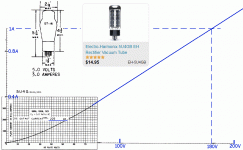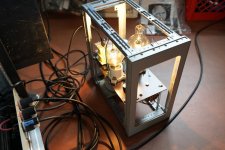Hi there, I'm pretty new here and are just getting my feet wet in the DIY PSU world
I'm looking to build me a PSU with a tube rectifier but I need 12V at 1~2A output. So I already figured out that this is not an easy task ^^
I was wondering if there is a way to do it. Like with a hybrid bridge or paralleling 2 or more tubes.
If it's not possible or would lead to a completely stupid design, what would be the nicest/cleanest design alternative?
Any tips are very welcome
Thank you in advance!
Hifoli
PS: PSU is for a DAC-Board
I'm looking to build me a PSU with a tube rectifier but I need 12V at 1~2A output. So I already figured out that this is not an easy task ^^
I was wondering if there is a way to do it. Like with a hybrid bridge or paralleling 2 or more tubes.
If it's not possible or would lead to a completely stupid design, what would be the nicest/cleanest design alternative?
Any tips are very welcome
Thank you in advance!
Hifoli
PS: PSU is for a DAC-Board
It's called a Tungar. It's a gas tube they used to charge batteries...
http://www.r-type.org/pdfs/tungar.pdf
Just use barrier diodes LOL
http://www.r-type.org/pdfs/tungar.pdf
Just use barrier diodes LOL
Last edited:
....tube rectifier but I need 12V at 1~2A output....
The drop of a vacuum rectifier can be over 100V, and no ordinary vacuum rectifiers are rated over a part-Amp.
The derivation attached is inexact, and 5U4 is not the biggest bottle, but was always a go-to for big amplifiers. You need nearly 200V in, and five bottles, to get 12V 1A out. The rectifier heats-up with 15 times the power that your DAC eats, about 180 Watts in plates. +Plus+ another 75 Watts in filaments.
And it will be far too saggy for powering digital chips. Building a vacuum Regulator at 12V 1A is even more "stupid".
Use solid-state and nail a bottle to the top.
Attachments
A pair of tungar bulbs will work in a FW CT configuration, but are impractical and ridiculously inefficient. 25A each @ 2.5V for heating power is typical. At 1A they will drop a few volts. I have some limited experience with them for field coil power supplies, but would not recommend them to a newbie.
They are still available new in China of course..
They are still available new in China of course..
Attachments
So silicon bridge is probably the way to go for the DAC. Sad i would have loved some blue glowing tubesThe drop of a vacuum rectifier can be over 100V, and no ordinary vacuum rectifiers are rated over a part-Amp.
The derivation attached is inexact, and 5U4 is not the biggest bottle, but was always a go-to for big amplifiers. You need nearly 200V in, and five bottles, to get 12V 1A out. The rectifier heats-up with 15 times the power that your DAC eats, about 180 Watts in plates. +Plus+ another 75 Watts in filaments.
And it will be far too saggy for powering digital chips. Building a vacuum Regulator at 12V 1A is even more "stupid".
Use solid-state and nail a bottle to the top.
Fake it with blue LEDs then??!So silicon bridge is probably the way to go for the DAC. Sad i would have loved some blue glowing tubes
Thermionics doesn't do high current densities I'm afraid. Gas tubes are something else, high current densities are available, but not at low voltage, for instance mercury rectifiers used to be the main high power device years ago.
I wanted to put the tube rectifier in it bc my preamp and amp are tube based and I liked the idea of having one in the DAC section but you are right: tubes are not suitable for low voltages.
So I already threw the idea and am now looking into silicon/schottky for the rectifier and some kind of LC filter after that.
So as I'm into math and numbers I'm now looking into circuits and transfer functions (although it seems its more like going throgh transformer/choke manufactures catalogues to see what one can find that gets close to what one needs and then build around that ^^)
So I already threw the idea and am now looking into silicon/schottky for the rectifier and some kind of LC filter after that.
So as I'm into math and numbers I'm now looking into circuits and transfer functions (although it seems its more like going throgh transformer/choke manufactures catalogues to see what one can find that gets close to what one needs and then build around that ^^)
Yeah the TV dampers where a gleam  rolleyes
rolleyes of hope but ultimately not the right thing for me.
of hope but ultimately not the right thing for me.
I'm already toying with the PSUD. It's a great tool and I will surely use it to simulate my circuit, but at the moment I kind of throw "random" parameters into the filters and look at the outcome ^^
I'd much prefer to get the transfer function of my circuit and plot some graphs
I'm already toying with the PSUD. It's a great tool and I will surely use it to simulate my circuit, but at the moment I kind of throw "random" parameters into the filters and look at the outcome ^^
I'd much prefer to get the transfer function of my circuit and plot some graphs
Always been tempted to build a low voltage high current valve rectifier but unless one uses Tungar it is not easy. Valve rectifiers don't seem to enjoy working or sounding very good at low voltages. A few years ago built a 6D22S rectifier into a Salas reg in order to power up a Salas simplistic riaa. Did not sound particularly good at all. Otoh i use NL616 in one of my amps which is capable of a lot more than 1-2A. A series of regulators could bring the voltage down to dac supply levels. Perhaps i should give it a try.
Afaik the Brinkmann valve rectified supply works similarly: after valve rectification the voltage gets regulated down to 24v over several cascaded regulators. It is good for just 500mA but that can easily be scaled up.
Afaik the Brinkmann valve rectified supply works similarly: after valve rectification the voltage gets regulated down to 24v over several cascaded regulators. It is good for just 500mA but that can easily be scaled up.
I once got an "amplifier" in the shop that had a little window with two "tubes" behind it. Real tubes, no less.
The tubes glowed BLUE of course, because they had an LED under them. The tubes themselves were merely "hot glued" in place on a plastic bracket. This is the kind of crap you'll see from those asian companies - typical of the marketing attitude towards idiotic superficiality.
This is the kind of crap you'll see from those asian companies - typical of the marketing attitude towards idiotic superficiality.
"Oh look, Henry!..... it's got TUBES!..... it's so NEAT!"
The tubes glowed BLUE of course, because they had an LED under them. The tubes themselves were merely "hot glued" in place on a plastic bracket.
 This is the kind of crap you'll see from those asian companies - typical of the marketing attitude towards idiotic superficiality.
This is the kind of crap you'll see from those asian companies - typical of the marketing attitude towards idiotic superficiality. "Oh look, Henry!..... it's got TUBES!..... it's so NEAT!"
Good morningOn a side note, are you sure you need to make a 1-2 amp supply? For an SS DAC? I'm having trouble imagining a DAC that needs that much.
You are right to be suspicious, it’s a DDDAC with 4 dac boards (so almost 4 times the power of a standard dac configuration i guess) and it’s more around 1A.
575 or 673 MV rectifiers FWCT circuit, and regulate with two 7242 tubes in parallel.
The MV rects above are still $80 or less depending where you find them. count a 15V drop across the tube. 575 and 673 are same except base.
7242 triple-cathode triode can run with low drop also, and make 900mA. 100W anode.
- Power triple cathode triode designed as series regulator for power supplies. Similar to 7241 with higher mu. 100W total anode dissipation, mu 9, current limited to 300mA per cathode, 900mA total. Three cathodes with single grid and plate connections; hard glass bulb, 7 pin giant base. Sylvania and Tung Sol
575/A/673 data:
https://frank.pocnet.net/sheets/140/5/575A.pdf
take note of anode starting volts, transformer must supply this peak voltage.
rated 1.75A, or 2A if fil. is run in quadrature phase to anode.
7242 data:
https://frank.pocnet.net/sheets/127/7/7242.pdf
You probably want almost a 100V drop across the tubes, and take note of cathode equalizing resistors required.
Using a choke input filter for good regulation, plate transformer should be about 135V-0-135V. Adjustable taps on primary may help the experiment.
so, 135V -20V rectifier drop = 115V.
115V * 0.9 = 103.5V.
103.5V - 12V = 91.5V across regulators.
For 1A use two 7242s and two 673s
For 2A use three 7242s and four 673s (or run the filaments in quadrature and use two). Or try the NL616s as suggested. What is the starting volts on those?
It's not practical at all, but the point is "yes you can".
The MV rects above are still $80 or less depending where you find them. count a 15V drop across the tube. 575 and 673 are same except base.
7242 triple-cathode triode can run with low drop also, and make 900mA. 100W anode.
- Power triple cathode triode designed as series regulator for power supplies. Similar to 7241 with higher mu. 100W total anode dissipation, mu 9, current limited to 300mA per cathode, 900mA total. Three cathodes with single grid and plate connections; hard glass bulb, 7 pin giant base. Sylvania and Tung Sol
575/A/673 data:
https://frank.pocnet.net/sheets/140/5/575A.pdf
take note of anode starting volts, transformer must supply this peak voltage.
rated 1.75A, or 2A if fil. is run in quadrature phase to anode.
7242 data:
https://frank.pocnet.net/sheets/127/7/7242.pdf
You probably want almost a 100V drop across the tubes, and take note of cathode equalizing resistors required.
Using a choke input filter for good regulation, plate transformer should be about 135V-0-135V. Adjustable taps on primary may help the experiment.
so, 135V -20V rectifier drop = 115V.
115V * 0.9 = 103.5V.
103.5V - 12V = 91.5V across regulators.
For 1A use two 7242s and two 673s
For 2A use three 7242s and four 673s (or run the filaments in quadrature and use two). Or try the NL616s as suggested. What is the starting volts on those?
It's not practical at all, but the point is "yes you can".
- Status
- This old topic is closed. If you want to reopen this topic, contact a moderator using the "Report Post" button.
- Home
- Amplifiers
- Power Supplies
- Tube rectifier PSU design for higher current?

